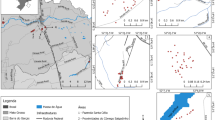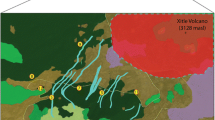Abstract
This study tested whether genetic parameters in Dipteryx alata populations, estimated from genomic and chloroplastidial microsatellite markers, were distributed according to a central-peripheral model, inferring which factors drive this spatial distribution of genetic variability within populations. For each of the 23 populations sampled throughout the species’ range, the mean number of alleles per locus, expected heterozygosity and intrapopulation fixation indices were calculated using a rarefaction approach based on 54 alleles from 8 nuclear microsatellites. Explanatory variables were grouped into three subsets: the ecological suitability estimated by combining different techniques of ecological niche modeling, variables expressing human occupation, and a historical variable represented by the first eigenvector from the pairwise F ST matrix based on cpDNA microsatellites. Each response variable was modeled using first (linear) and second (quadratic) order trend surface analysis (TSA). Multiple regressions were then used to evaluate the relative effects of the explanatory variables, based on AIC multi-model selection. In general, the genetic parameters did not follow a classical central-periphery model. Ecological suitability had a significance influence in all genetic parameters, so more suitable regions have higher genetic diversity and low endogamy. There was also a relationship between fixation indices and human impacts. The high genetic diversity in the southwestern region of Cerrado suggested that recent range expansion (after the Last Glacial Maximum) may also influenced the observed intrapopulation genetic patterns. Thus, complex combinations of both historical and ecological drivers, as well as contemporary human occupation, seem to drive current genetic composition within D. alata populations throughout its geographic range.


Similar content being viewed by others
References
Anderson RP, Martinez-Meyer E (2004) Modeling species’ geographic distributions for preliminary conservation assessments: an implementation with the spiny pocket mice (Heteromys) of Ecuador. Biol Conservation 116:167–179
Araújo MB, New M (2007) Ensemble forecasting of species distributions. Trends Ecol Evol 22:42–47
Barnett R, Yamaguchi N, Barnes I, Cooper A (2006) The origin, current diversity and future conservation of the modern lion (Panthera leo). Proc Royal Soc B Biol Sci 273:2119–2125
Bonaccorso E, Koch I, Peterson AT (2006) Pleistocene fragmentation of Amazon species’ ranges. Diversity Distrib 12:157–164
Burnham KP, Anderson DR (2002) Model selection and multi-model inference: a practical information-theoretic approach. Springer, Heidelberg
Collevatti RG, Lima JS, Soares TN, Telles MPC (2010) Spatial genetic structure and life history traits in Cerrado tree species: inferences for conservation. Nat Conservation 8:54–59
Collevatti RG, Telles MPC, Nabout JC, Chaves LJ, Soares TN (2013a) Demographic history and the low genetic diversity in Dipteryx alata (Fabaceae) from Brazilian Neotropical savannas. Heredity 111:97–105
Collevatti RG, Terribile LC, Oliveira G, Lima-Ribeiro MS, Nabout JC, Rangel TF, Diniz-Filho JAF (2013b) Drawbacks in paleodistribution modelling: the case of South American seasonally dry forests. J Biogeogr 40:345–358
Creste C, Tulmann Neto A, Figueira A (2001) Detection of single sequence repeat polymorphisms in denaturing polyacrylamide sequencing gels by silver staining. Pl Molec Biol Rep 19:299–306
Diniz-Filho JAF, Nabout JC, Bini LM, Soares TN, Telles MPC, De Marco P Jr, Collevatti RG (2009a) Niche modelling and landscape genetics of Caryocar brasiliense (“Pequi” tree: Caryocaraceae) in Brazilian Cerrado: an integrative approach for evaluating central–peripheral population patterns. Tree Genet Genomes 5:617–627
Diniz-Filho JAF, Bini LM, Rangel TF, Loyola RD, Hof C, Nogues-Bravo D, Araújo MB (2009b) Partitioning and mapping uncertainties in ensembles of forecasts of species turnover under climate change. Ecography 32:897–906
Diniz-Filho JAF, Nabout JC, Telles MPC, Soares TN, Rangel TFLVB (2009c) A review of techniques for spatial modeling in geographical, conservation and landscape genetics. Genet Molec Biol 32:203–211
Diniz-Filho JAF, Melo DB, Oliveira G, Collevatti RG, Soares TN, Nabout JC, Lima JS, Dobrowolski R, Chaves LJ, Naves RV, Telles MPC (2012) Planning for optimal conservation of geographical genetic variability within species. Conservation Genet 13:1085–1093
Eckert CG, Samis KE, Lougheed SC (2008) Genetic variation across species’ geographical ranges: the central-marginal hypothesis and beyond. Molec Ecol 17:1170–1188
Epperson BK (2003) Geographical Genetics. Princeton University Press, Princeton
Garcia RAV, Rangel PN, Brondani C, Martins WS, Melo LC, Carneiro MS, Borba TCO, Brondani RPV (2011) The characterization of a new set of EST—derived simple sequence repeat (SSR) markers as a resource for the genetic analysis of Phaseolus vulgaris. BMC Genet 12(41):1–14
Garner TWJ, Pearman PB, Angelone S (2004) Genetic diversity across a vertebrate species’ range: a test of the central-peripheral hypothesis. Molec Ecol 13:1047–1053
Gaston KJ (2003) The structure and dynamics of geographic ranges. Oxford University Press, Oxford
Gaston KJ, Blackburn TM (2000) Pattern and process in macroecology. Blackwell, London
Ginzburg LR, Golenberg EM (1985) Lectures in theoretical population biology. Prentice-Hall, Englewood Cliffs
Goudet J (2005) Hierfstat, a package for R to compute and test variance components and F-statistics. Molec Ecol Notes 5:184–186
Harris SA, Robinson JP, Juniper BE (2002) Genetic clues to the origin of the apple. Trends Genet 18:426–430
Hewitt GM (1999) Post-glacial re-colonization of European biota. Biol J Linn Soc 68:87–112
Hijmans RJ, Guarino L, Bussink C, Barrantes I, Rojas E (2005) DIVA-GIS, Version 5.2. http://www.diva-gis.org. Accessed 8 Apr 2014
Holderegger R, Wagner HH (2006) A brief guide to landscape genetics. Landscape Ecol 21:793–796
Hopper SD, Gioia P (2004) The Southwest Australian floristic region: evolution and conservation of a global hot spot of biodiversity. Annual Rev Ecol Evol Sys 35:623–650
Howes BJ, Lougheed SC (2008) Genetic diversity across the range of a temperate lizard. J Biogeogr 35:1269–1272
Johansson M, Primmer CR, Merila J (2006) History vs. current demography: explaining the genetic population structure of the common frog (Ranatemporaria). Molec Ecol 15:975–983
Johnson JP, Omland KS (2004) Model selection in ecology and evolution. Trends Ecol Evol 19:101–108
Kirkpatrick M, Barton NH (1997) Evolution of a species’ range. Amer Nat 150:1–23
Klink CA, Machado RB (2005) Conservation of the Brazilian Cerrado. Conservation Biol 19:707–713
Klink CA, Moreira AG (2002) Past and current human occupation, and land use. In: Oliveira PS, Marquis RJ (eds) The Cerrados of Brazil. Columbia University Press, New York, pp 69–88
Lira-Noriega A, Manthey JD (2014) Relationship of genetic diversity and niche centrality: a survey and analysis. Evolution 68:1082–1093
Manel S, Schwartz MK, Luikart G, Taberlet P (2003) Landscape genetics: combining landscape ecology and population genetics. Trends Ecol Evol 18:189–197
Martinez-Meyer E, Diáz-Porras D, Peterson AT, Yánez-Arenas (2012) Ecological niche structure and rangewide abundance patterns of species. Biol Lett 9:20120637
Maurer BA (1994) Geographical population analysis: tools for the analysis of biodiversity. Blackwell Scientific Publications, Oxford
Nabout JC, Soares TN, Diniz-Filho JAF, De Marco Júnior P, Telles MPC, Naves RV, Chaves LJ (2010) Combining multiple models to predict the geographical distribution of the Baru tree (Dipteryx alata Vogel) in the Brazilian Cerrado. Brazil J Biol 70(4):911–919
Nabout JC, Oliveira G, Magalhães G, Magalhães MR, Terribile LC (2011) Global climate change and the production of Pequi fruits (Caryocar brasiliense) in the Brazilian Cerrado. Nat Conservation 9:55–60
Oliveira MIB, Sigrist MR (2008) Fenologia reprodutiva, polinização e reprodução de Dipteryx alata Vog. (Leguminosae-Papilionoidae) em Mato Grosso do Sul. Revista Brasil Bot 31:195–207
Oliveira-Filho AT, Ratter JA (2002) Vegetation physiognomies and woddy flora of the cerrado Biome. In: Oliveira PS, Marquis RJ (eds) The Cerrados of Brazil. Columbia University Press, New York, pp 91–120
Petit RJ, Pineau E, Demesure B, Bacilieri R, Ducousso A, Kremer A (1997) Chloroplast DNA footprints of postglacial recolonization by oaks. Proc Natl Acad Sci USA 94:9996–10001
Petit RJ, Duminil J, Fineschi S, Hampe A, Salvini D, Vendramin GG (2005) Comparative organization of chloroplast, mitochondrial and nuclear diversity in plant populations. Molec Ecol 14:689–701
Pfeifer M, Schatz B, Xavier PF, Passalacqua NG, Fay MF, Carey PD, Jeltsch F (2009) Phylogeography and genetic structure of the orchid Himantoglossum hircinum (L.) Spreng. across its European central–marginal gradient. J Biogeogr 36:2353–2365
Provan J, Powell W, Hollingsworth PM (2001) Chloroplast microsatellites: new tools for studies in plant ecology and evolution. Trends Ecol Evol 16:142–147
Ramos ACS, Lemos-Filho JP, Ribeiro RA, Santos FR, Lovato MB (2007) Phylogeography of the tree Hymenaea stigonocarpa (Fabaceae: Caesalpinioideae) and the influence of quaternary climate changes in the Brazilian Cerrado. Ann Bot (Oxford) 100:1219–1228
Rangel TF, Loyola RD (2012) Labeling ecological niche models. Nat Conservation 10:119–126
Rangel TF, Diniz-Filho JAF, Bini LM (2010) SAM: a comprehensive application for spatial analysis in macroecology. Ecography 33:46–50
Sagarin RD, Gaines SD (2002) The ‘abundant centre’ distributions: to what extent is it a biogeographical rule? Ecol Lett 5:137–147
Sagarin RD, Gaines SD, Gaylord B (2006) Moving beyond assumptions to understand abundance distributions across the range of species. Trends Ecol Evol 21:524–530
Sano SM, Ribeiro JF, Brito MA (2004) Baru: Biologia e uso. Embrapa, Planaltina
Sawyer D (2008) Climate change, biofuels and eco-social impacts in the Brazilian Amazon and Cerrado. Philos Trans Ser B 363:1747–1752
Soares TN, Chaves LJ, Telles MPC, Diniz-Filho JAF, Resende LV (2008) Landscape conservation genetics of Dipteryx alata (“baru” tree: Fabaceae) from Cerrado region of central Brazil. Genetica 132:9–19
Soares TN, Melo DB, Resende LV, Vianello RP, Chaves LJ, Collevatti RG, Telles MPC (2012) Development of microsatellite markers for the neotropical tree species Dipteryx alata (Fabaceae). Amer J Bot 99:e72–e73
Soulé M (1973) The epistasis cycle: a theory of marginal populations. Annual Rev Ecol Syst 4:165–187
Telles MPC, Diniz-Filho JAF, Bastos RP, Soares TN, Guimarães LD, Lima LP (2007) Landscape genetics of Physalaemus cuvieri in Brazilian Cerrado: correspondence between population structure and patterns of human occupation and habitat loss. Biol Conservation 139:37–46
Telles MPC, Dobrovolski R, Souza KS, Lima JS, Collevatti RG, Soares TN, Chaves LJ, Diniz-Filho JAF (2014) Disentangling landscape effects on population genetic structure of a Neotropical savana tree. Nat Conservation 12:65–70
Terribile LC, Lima-Ribeiro MS, Araújo M, Bizao N, Collevatti RG, Dobrovolski R, Franco A, Guilhaumon F, Lima JS, Murakami DM, Nabout JC, Oliveira G, Oliveira LK, Rabello SG, Rangel TF, Simon LM, Soares TN, Telles MPC, Diniz-Filho JAF (2012) Areas of climate stability of species ranges in the Brazilian Cerrado: disentangling uncertainties through time. Nat Conservation 10:152–159
Torres NM, De Marco Jr P, Santos T, Silveira L, Jácomo AT, Diniz-Filho JAF (2012) Can species distribution modelling provide estimates of population densities? A case study with jaguars in the Neotropics. Diver Distrib 18:615–627
Van Rossum F, Prentice HC (2004) Structure of allozyme variation in Nordic Silene nutans (Caryophyllaceae): population size, geographical position and immigration history. Biol J Lin Soc 81:357–371
Vucetich JA, Waite TA (2003) Spatial patterns of demography and genetic processes across the species’ range: null hypotheses for landscape conservation genetics. Conservation Genet 4:639–645
Weising K, Gardner RC (1999) A set of conserved PCR primers for the analysis of simple sequence repeat polymorphisms in chloroplast genome of dicotyledonous angiosperms. Genome 42:9–19
Acknowledgments
We thank two anonymous reviewers for suggestions that widely improved early versions of the manuscript. Our research program integrating macroecology and molecular ecology of plants has been continuously supported by several grants and fellowships to the research network GENPAC (Geographical Genetics and Regional Planning for natural resources in Brazilian Cerrado) from CNPq/MCT/CAPES (projects # 564717/2010-0, 563624/2010-8 and 563727/2010-1) and by the “Núcleo de Excelência em Genética e Conservação de Espécies do Cerrado”—GECER (PRONEX/FAPEG/CNPq CH07-2009).We thank Thiago F. Rangel for providing access to computational platform BIOENSEMBLES, which was essential to build the niche models. Field work has been supported by Systema Naturae Consultoria Ambiental LTDA. All authors are also supported by productivity grants from CNPq.
Author information
Authors and Affiliations
Corresponding author
Additional information
Handling editor: Sylvain Razafimandimbison.
Rights and permissions
About this article
Cite this article
Soares, T.N., Diniz-Filho, J.A.F., Nabout, J.C. et al. Patterns of genetic variability in central and peripheral populations of Dipteryx alata (Fabaceae) in the Brazilian Cerrado. Plant Syst Evol 301, 1315–1324 (2015). https://doi.org/10.1007/s00606-014-1155-0
Received:
Accepted:
Published:
Issue Date:
DOI: https://doi.org/10.1007/s00606-014-1155-0




